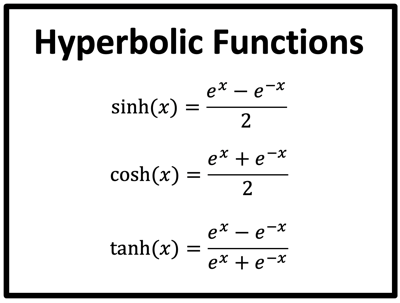MITIHANI POPOTE EXAMINATIONS SERIES
FORM SIX TOPIC TES
ADVANCED MATHEMATICS - HYPERBOLIC FUNCTIONS
Question 1
(a) Find the condition for equation a cosh x + b sinh x = c to have equal roots.
(b) Show that the condition of the equation a cosh x + sinh x + b = 0 where a and b are real constants to have real roots is a² - b² ≤ 1.
Question 2
(a) If sec θ + tan θ = eu, show that:
i. cosh u = sec θ
ii. sinh u = tan θ
(b) If tanh-1 x = y, show that x = (e2y - 1)/(e2y + 1) and hence express in logarithmic form.
(c) Show that:
i. tanh-1((x² - 1)/(x² + 1)) = ln x
ii. tanh-1((x² - a²)/(x² + a²)) = ln(x/a)
Question 3
(a) If tanh-1 x + tanh-1 y = ½ ln 5, prove that y = (2 - 3x)/(3 - 2x).
(b) Find in logarithmic form the solution of 10 sinh y + 10 cosh y = 10.
(c) Sketch the graph of tanh-1 x and state its domain and range.
(d) Use an appropriate hyperbolic substitution to evaluate ∫√(x² + 2x - 1) dx.
Question 4
(a) Given that sinh x = tan θ. Prove that x = ln |sec θ + tan θ|.
(b) Find the values of x for which 3 cosh x + sinh x = 2.
(c) Express tanh-1 x in logarithmic form.
Question 5
(a) (i) If cos x = tanh p, prove that ep = cot(x/2).
(ii) State the asymptotes for y = tanh x and by reflecting the graph of y = tanh x on the line y = x, sketch the graph of y = tanh-1 x on the xy plane.
(b) Investigate the stationary value of cosh 3x - 12 cosh x.
(c) Prove that ∫√(a² + b²x²) dx = (ax/2) + ½ sinh-1(bx/a) + c, where c is the constant of integration.
Question 6
(a) Solve the equation 4 + 6(e2x + 1) tanh x = 11 cosh x + 11 sinh x.
(b) Investigate the stationary point of h(x) = a cosh(x/a).
(c) Express as a single hyperbolic value of the expression:
(1 + sinh 2x - cosh 2x)/(1 - sinh 2x - cosh 2x)
(d) Express sinh-1(ln x) as a single natural logarithm as x becomes a very large number.
Additional Hyperbolic Function Questions
1. If sinh x = 3/4, find the values of:
i. cosh x
ii. tanh x
iii. sech x
iv. coth x
2. Prove the identity: cosh(x + y) = cosh x cosh y + sinh x sinh y
3. Solve for x: 2 cosh 2x - 3 sinh x = 0
4. Show that: tanh-1 x = ½ ln((1 + x)/(1 - x)) for |x| < 1
MITIHANI POPOTE EXAMINATION SERIES
FORM SIX TOPIC TEST
ADVANCED MATHEMATICS - HYPERBOLIC FUNCTIONS SOLUTIONS
Question 1(a)
Find the condition for equation a cosh x + b sinh x = c to have equal roots.
Question 2(a)
If sec θ + tan θ = eu, show that cosh u = sec θ.
Question 2(b)
If tanh-1 x = y, show that x = (e2y - 1)/(e2y + 1).
Question 3(a)
If tanh-1 x + tanh-1 y = ½ ln 5, prove that y = (2 - 3x)/(3 - 2x).
Question 4(b)
Find the values of x for which 3 cosh x + sinh x = 2.
Question 5(c)
Prove that ∫√(a² + b²x²) dx = (ax/2) + ½ sinh-1(bx/a) + c.



No comments
Post a Comment